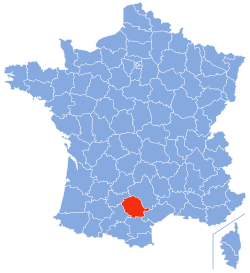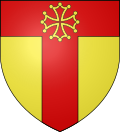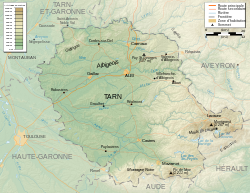Tarn (department)
Tarn (Occitan: [Tarn] Error: {{Lang}}: text has italic markup (help)) is a French department in the Occitanie region in the southwest of France named after the Tarn river.
 | |
 Location of Tarn in France | |
| Coordinates: 43°54′35″N 2°6′33″E / 43.90972°N 2.10917°ECoordinates: 43°54′35″N 2°6′33″E / 43.90972°N 2.10917°E | |
| Country | France |
| Region | Occitanie |
| Département | 4 March 1790 |
| Prefecture | Albi |
| Subprefecture | Castres |
| Government | |
| • President | Christophe Ramond[1] |
| Area | |
| • Total | 5,757.9 km2 (2,223.1 sq mi) |
| Population (2014)[3] | |
| • Total | 384,474 |
| • Density | 66.7733/km2 (172.9421/sq mi) |
| Time zone | UTC+1 (CET) |
| • Summer (DST) | UTC+2 (CEST) |
| ISO 3166 code | FR-81 |
| Arrondissements | 2 |
| Cantons | 23 |
| Communes | 320 |
| Website | http://www.tarn.fr |
Its prefecture and largest city is Albi.
History
Tarn is one of the original 83 departments created during the French Revolution on 4 March 1790. It was created from a part of the old province of Languedoc.
The new department had five districts: Albi, Castres, Lavaur, Gaillac, Lacaune. The capitals (now prefectures) were, alternatively, Albi and Castres but, from 1790 to 1797, the capital was only Albi; in 1797, the capital was moved to Castres.[4]
In 1800, Albi became again the capital of the department and the arrondissements were created; the department had four arrondissements: Albi, Castres, Gaillac and Lavaur. In 1926, the arrondissements of Gaillac and Lavaur were eliminated.[4]
Geography
Tarn is part of the Occitanie region and has an area of 5,757.9 km2 (2,223 sq mi).[2]
The department borders with 5 departments, all in the Occitanie region:
- Hérault (southeast)
- Aude (south)
- Aveyron (north and east)
- Haute-Garonne (southwest and west)
- Tarn-et-Garonne (northwest)
While the valley of the Tarn river, the main river of the department, forms a plain, the central part of the department has many hills. The main mountain ranges are the Monts de Lacaune, in the southeast, and the Montagne Noire in the south.
The Monts de Lacaune ("Mountains of Lacaune") mountain range is near the town of Lacaune; its highest point, and the highest of the Tarn department, is Puech de Rascas, (43°40′52″N 2°43′41″E / 43.68111°N 2.72806°E), at 1,270 m (4,170 ft) above sea level.[5]
The Montagne Noire (Occitan: [Montanha Negra] Error: {{Lang}}: text has italic markup (help), "Black Mountain") is a mountain range in central southern France. It is at the southwestern end of the Massif Central in the border area of the Tarn, Hérault and Aude departments. Its highest point is the Pic de Nore (43°25′28″N 2°27′45″E / 43.42444°N 2.46250°E) at 1,211 m (3,973 ft) high.[6] The mountain is within the Haut-Languedoc Regional Natural Parc (French: [Parc naturel régional du Haut-Languedoc] Error: {{Lang}}: text has italic markup (help)).
The main river in the department are the Tarn and its tributary, the Agout river.
Climate
The climate of Albi is an oceanic climate with template summers, Cfb (Marine West Coast Climate) in the Köppen climate classification.[7]
The average amount of precipitation for the year in Albi is 1,023.6 mm (40.3 in). The month with the most precipitation on average is November with 101.6 mm (4.0 in) of precipitation. The month with the least precipitation on average is July with an average of 66 mm (2.6 in).
The average temperature for the year in Albi is 13.4 °C (56.1 °F). The warmest month, on average, is July with an average temperature of 22.3 °C (72.1 °F). The coolest month on average is January, with an average temperature of 5.4 °C (41.7 °F).
Administration
The department is managed by the Departamental Council of the Tarn in Albi. Tarn is part of the region of Occitanie.
Administrative divisions
There are 2 arrondissements (districts), 23 cantons and 320 communes (municipalities) in Tarn.[8]
| INSEE code |
Arrondissement | Capital | Population[9] (2014) |
Area[10] (km²) |
Density (Inh./km²) |
Communes |
|---|---|---|---|---|---|---|
| 811 | Albi | Albi | 190,101 | 2,731.7 | 69.6 | 169 |
| 812 | Castres | Castres | 194,373 | 3,026.2 | 64.2 | 151 |
The following is a list of the 23 cantons of the Tarn department (with their INSEE codes), following the French canton reorganisation which came into effect in March 2015:[11]
- Albi-1 (8101)
- Albi-2 (8102)
- Albi-3 (8103)
- Albi-4 (8104)
- Carmaux-1 Le Ségala (8105)
- Carmaux-2 Vallée du Cérou (8106)
- Castres-1 (8107)
- Castres-2 (8108)
- Castres-3 (8109)
- Les Deux Rives (8110)
- Gaillac (8111)
- Graulhet (8112)
- Le Haut Dadou (8113)
- Les Hautes Terres d'Oc (8114)
- Lavaur Cocagne (8115)
- Mazamet-1 (8116)
- Mazamet-2 Vallée du Thoré (8117)
- La Montagne noire (8118)
- Le Pastel (8119)
- Plaine de l'Agoût (8120)
- Les Portes du Tarn (8121)
- Saint-Juéry (8122)
- Vignobles et Bastides (8123)
Demographics
The inhabitants of Tarn are known, in French, as Tarnais (women: Tarnaises).[12]
Tarn has a population, in 2014, of 384,474,[3] for a population density of 66.8 inhabitants/km2. The arrondissement of Castres, with 194,373 inhabitants, is the arrondissement with more inhabitants. The arrondissement of Albi has 190,101 inhabitants.[9]
The city with more people living in it is the capital, Albi (49,531). The subprefecture of Castres has 41,382 inhabitants.[9]
Evolution of the population in Tarn

The cities with more than 6,000 inhabitants in the department are:
| City | Population (2014)[9] |
Arrondissement |
|---|---|---|
| Albi | 49,531 | Albi |
| Castres | 41,382 | Castres |
| Gaillac | 15,077 | Albi |
| Graulhet | 12,063 | Castres |
| Lavaur | 10,592 | Castres |
| Mazamet | 10,173 | Castres |
| Carmaux | 9,542 | Albi |
| Saint-Sulpice-la-Pointe | 8,642 | Castres |
| Saint-Juéry | 6,792 | Albi |
| Labruguière | 6,478 | Castres |
| Aussillon | 6,121 | Castres |
Gallery
Jean Jaurès square, Castres, by night
The town of Penne from the Grésigne forest
Sunflowers near Salvagnac
Tarn (department) Media
Castres is best known in French political history as the birthplace of Socialist leader Jean Jaurès.
Related pages
References
- ↑ "Le Président" (in French). Tarn.fr. Archived from the original on 18 July 2017. Retrieved 16 September 2017.
{{cite web}}: CS1 maint: unrecognized language (link) - ↑ 2.0 2.1 "Département du Tarn (81) - Résumé statistique". Publications et statistiques pour la France ou les régions (in French). Institut national de la statistique et des études économiques - INSEE. Retrieved 23 October 2016.
{{cite web}}: CS1 maint: unrecognized language (link) - ↑ 3.0 3.1 "Populations légales 2014 des départements et des collectivités d'outre-mer" (in French). Institut national de la statistique et des études économiques - INSEE. Retrieved 29 January 2017.
{{cite web}}: CS1 maint: unrecognized language (link) - ↑ 4.0 4.1 "Historique du Tarn". Le SPLAF (in French). Retrieved 26 May 2014.
{{cite web}}: CS1 maint: unrecognized language (link) - ↑ "Puech de Rascas, France". Peakbagger.com. Retrieved 23 October 2016.
- ↑ "Pic de Nore, France". Peakbagger.com. Retrieved 23 October 2016.
- ↑ "Albi, France - Köppen Climate Classification". Weatherbase. Retrieved 23 October 2016.
- ↑ "Département du Tarn (81)". Géographie administrative et d'étude (in French). Institut national de la statistique et des études économiques - INSEE. Retrieved 8 February 2017.
{{cite web}}: CS1 maint: unrecognized language (link) - ↑ 9.0 9.1 9.2 9.3 "Régions, départements, arrondissements, cantons et communes" (PDF). Populations légales 2014 (in French). Institut national de la statistique et des études économiques - INSEE. Retrieved 1 February 2017.
{{cite web}}: CS1 maint: unrecognized language (link) - ↑ "Département du Tarn (81)". Comparateur de territoire (in French). Institut national de la statistique et des études économiques - INSEE. Retrieved 1 February 2017.
{{cite web}}: CS1 maint: unrecognized language (link) - ↑ "Décret n° 2014-170 du 17 février 2014 portant délimitation des cantons dans le département du Tarn" (in French). Légifrance.gouv.fr. Retrieved 23 October 2016.
{{cite web}}: CS1 maint: unrecognized language (link) - ↑ "Tarn (81)" (in French). habitants.fr. Retrieved 26 May 2014.
{{cite web}}: CS1 maint: unrecognized language (link)
Other websites
| Wikimedia Commons has media related to Lua error in Module:Commons_link at line 62: attempt to index field 'wikibase' (a nil value).. |
- General Council website Archived 2010-12-03 at the Wayback Machine (in French)
- Prefecture website Archived 2007-01-07 at the Wayback Machine (in French)
- Discover Tarn - Comité Départemental du Tourisme du Tarn Archived 2016-07-22 at the Wayback Machine









